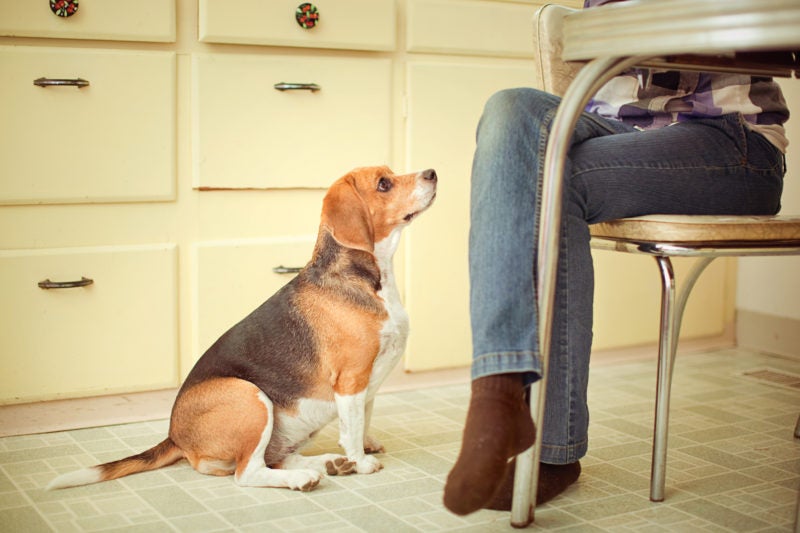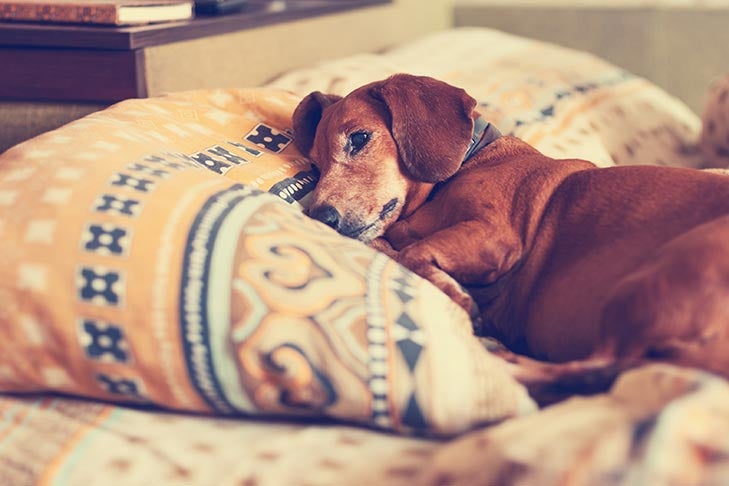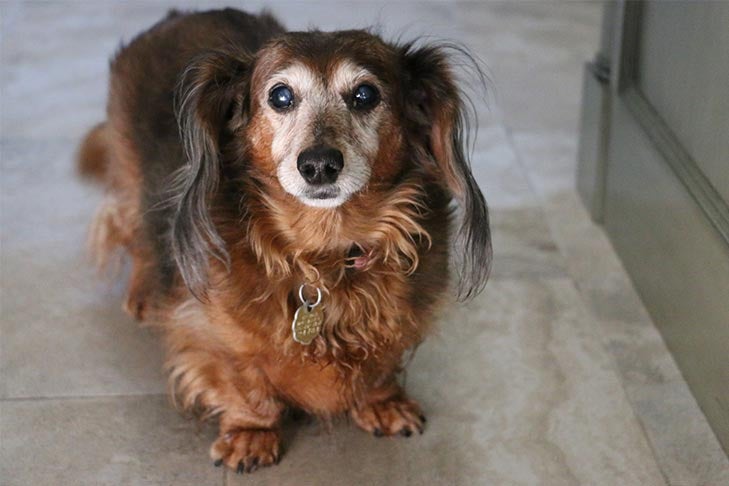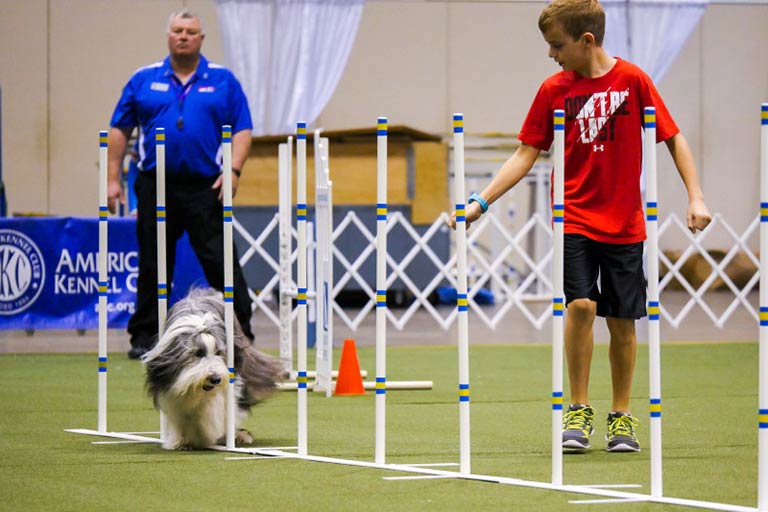If your pooch is looking a bit more pudgy than usual, it’s actually quite common. The battle of the bulge isn’t just something people face — so do pets. In fact, according to a 2018 survey conducted by the Association for Pet Obesity Prevention, 55.8 percent of dogs in the United States are overweight or obese. And that extra weight can cause a lot of health issues for your dog, including canine diabetes, heart problems, and painful arthritis.
Wondering how to tell if your dog is fat or overweight and needs to lose a few pounds? Read on to examine the signs you can look for to determine whether or not your dog is fat and how you can get your pup into shape to stay healthy and happy for years to come.
Check Your Dog’s Body Shape
One of the simplest ways to determine if your dog is fat is to look at the body shape. Looking at your dog from above, if you notice that the pup looks rather rotund and oval-shaped, it’s likely that your dog is fat. If, on the other hand, you notice that your dog has a defined waist toward the rear and a straight build down the sides, then they’re probably at a healthy weight.

Feel for Your Dog’s Ribs
The feel and prominence of your dog’s ribs are a major indicator of weight issues, says Dr. Sara Ochoa, DVM, a veterinary advisor for DogLab and practitioner at Whitehouse Veterinary Animal Hospital in Whitehouse, Texas. “If your dog’s ribs aren’t extremely prominent and you can easily feel them without having to press hard, then the dog is fit,” she says. For overweight dogs, it’s very difficult to feel their ribs because there is too much fat in the way.
Look at Your Dog From the Side
A sagging waist or swinging stomach is another tell-tale sign of a fat dog. When viewing your dog from the side, look for a waist that is slightly raised rather than simply hanging down and oval-shaped. “A dog’s abdomen should not be the same level as the chest and should be tucked up,” says Dr. Ochoa.
Check Your Dog for Fat Pads
Excess fat on your dog’s body is also a major indicator of being overweight. “Some animals will have fat sacks between their legs that will waddle when they walk,” says Dr. Ochoa. She also recommends inspecting your dog’s hips during petting sessions. “Overweight dogs will have fat pads on the top of their hips.”
Examine Your Dog’s Behavior
Overweight and obese dogs are typically inactive and spend a lot of time scarfing down their food. If you notice that your dog has become a couch potato, has trouble walking, exhibits trouble breathing when walking, and generally appears to have trouble moving about, they might be fat. Also, if you free-choice feed your dog throughout the day, this can encourage obesity.

Weigh Your Dog
The best way to tell if your dog is overweight or obese is with a weigh-in at your veterinarian. Your vet can then tell you whether your dog is overweight according to your dog’s size and breed. Remember that a healthy weight will look different for every breed. For example, most sighthounds should have visible ribs.
They will also examine your dog’s body and compare it to a body condition score chart, which ranks a dog’s body type by shape. Typically, scores range from one to nine, with one being very underweight and nine being extremely overweight. The target body condition usually lies in between, around four to five.
Consider the Health Effects of Being Overweight
While having a portly pup may seem adorable, those extra pounds can pack quite the punch when it comes to dogs developing obesity-related health issues. Overweight dogs can develop a number of serious health conditions, including:
- Diabetes.
- Skin problems.
- Heart problems.
- Joint problems.
- Kidney disease.
- Canine arthritis.
- Certain cancers.
- Liver problems.
- Mobility issues.
- Breathing problems.
- High blood pressure.
Carrying extra weight is especially hard on breeds like dachshunds because they can develop back problems and chubby brachycephalic dog breeds may experience trouble breathing. Large dog breeds may even develop canine orthopedic issues, especially when they’re still growing, if they become overweight.
Canine obesity-related health issues can cause long-term problems for dogs and can shave years off your pup’s life. Fortunately, by losing weight, your pooch can avoid or even reverse many of these conditions.

Develop a Dog Weight Loss Plan
If your veterinarian determines that your dog is overweight, you’ll have to start a weight-loss plan. The two things to target are reducing calorie intake and increasing the amount of time you exercise your dog.
Encourage your dog to exercise by going on 10 to 15 minute walks each day to start, recommends Dr. Ochoa. Gradually increase the amount of time you spend walking your dog per day and the briskness of the walks to up to 2 hours total each day, depending on your dog’s breed and age, according to the People’s Dispensary for Sick Animals. Most importantly, make the walks fun by praising your dog for being active and rewarding your pup with lots of attention. You can also sign your pooch up for a canine agility class — as part of an exercise routine.
If agility isn’t the right fit for your dog, there are many other AKC Sports that can provide fun and exercise for you and your pup.

With the help of your veterinarian, develop a calorie and portion-control weight loss plan for your dog. “Just decreasing the amount of food your dog eats per day by about 10 percent will help your pet lose weight,” says Dr. Ochoa. Your vet can also recommend a high-fiber, lower-calorie food for your pup that will keep them feeling fuller for longer.
Once you know just how much to feed your dog each day, divide your pup’s meals into a morning and evening portion. This way, your dog won’t become hungry later in the day.
Most importantly, keep treats to a minimum, says Dr. Ochoa. “Treats and cookies have added calories. By decreasing the amount of treats given or totally eliminating them from their diet will help your dog lose weight,” she recommends. You can also supplement your dog’s diet with healthy, low-calorie snacks like steamed or raw vegetables that are safe for dogs like celery, carrots, green beans, broccoli, and cucumbers.

